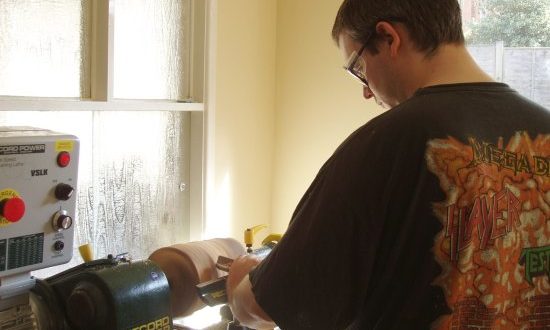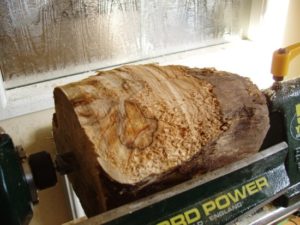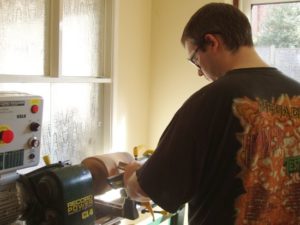April was the first full month where I could turn and therefore it saw me do a great deal more turning than I managed in March. I started the month with the intention of leaning to produce a good bead and I think I got close to being able to do that. The first piece I produced this month was all beads.
I cut these beads using a beading and parting tool as directed in Woodturning – A Foundation Course by Keith Rowley. The description in the book is good but I still found myself a little confused at times. While producing this piece I decided to get hold of a video which would show be what was being described and hopefully give me an insight into good technique that no amount of description could. Even so I muddled on an finished the piece after a couple of days. Some of the beads are actually quite round and well balanced.
The next piece I produced was a little more exciting. I decided it was time to move on and try some new cuts so I got the spindle gouge out and produced some coves. The beads on this piece are quite interesting – they are more like balls on a string than beads. The finish on this piece is very poor which I suspect it partially due to the wood being quite thin. The reason the wood is thin is because I had already cut a series of beads on this piece and roughed them off.
I decided that I had had enough of cutting beads and wanted to try something a little more adventurous. I chose a sample spindle shape from my woodturning book and decided to make that. The end result, which you can see below, is fairly close to the design and I was very proud of this piece when I had finished it and sanded it so that I could see it’s full beauty. There are a couple of mistakes on the piece – such as a flat where there should be a point because the spindle gouge wandered – but generally the piece is as per the diagram. The size is all over the place because I don’t currently have a set of callipers.

Ever since we moved into our current house there has been something that has been bugging me – a tree stump. The previous owner had some raised beds put into the back garden and a tree removed. It is fairly clear that they intended to cover where the tree was with soil and make it part of the planter. For some reason the builders that put in the beds didn’t remove the tree stump which meant the retaining wall for the soil stopped early. This left one planter with a hole at the end. I had eyed up the job of removing this stump before and considered it difficult at best because access was very severely limited (which is why I know the wall was built after the tree was cut down).
Since we wanted to use that bit of planter I decided it was time to remove the root. In I went with hammer and chisel and after much work I got the root out. The root then sat on the patio for a week or two while I worked up the effort to chop it up for burning. On a sunny Saturday afternoon I decided to tidy up the patio and saw the stump. “Wait a mo” I thought, “I can turn that”. No sooner had the idea crossed my mind that I had whipped out the bow saw and squared up the ends.
With much trepidation I secured the piece on the lathe. I was very scared. I had never turned a piece of real wood before and certainly never a piece that was this off balance. The variable speed of the lathe really came into it’s own here. Standing well back I switched on the lathe. The piece started spinning slowly. I gently turned up the speed to 100 rpm then 200 rpm and then up to 300 rpm. Due to the size of the outer root ball I decided this was as fast as I was happy to rough down at and gently introduced the tool to the wood. To my complete surprise I didn’t end up dead. In fact it started cutting quite nicely. I roughed off the worst points and moved the rest in then did some more. When I stopped the lathe a second time I was delighted to see that the wood was spalted.
It was then just a matter of moving the rest in and upping the speed until the root was turned into a cylinder. The root had been in the ground at least 5 years so most of the outer wood was very soft and couldn’t be saved. From a 6 inch root I managed to get about 3 inches of good solid wood.
I learnt a couple of things while turning this root. Firstly, water logged wood is very wet to turn. Water sprayed out at me as I made a cut, especially right to left. Secondly, turning things that are a bit out of balance is scary but possible as long as one is very careful. Thirdly, water logged wood is very soft. A couple of times when I got a dig-in the drive centre drilled it’s way into the wood which was quite a shock.
This blank is now drying out in my workshop and so far hasn’t developed any shakes. When I get good enough to do the wood justice I will make a salt or pepper pot out of it probably. I will also try and remember to dig out a photograph of the final blank.
Next on the lathe were some big beads. After cutting a large number of small beads I felt I needed some practice cutting larger shapes as the movements are more pronounced. Somewhere around here I switched over from using a slicing cut when producing a V to using a plunge cut. I found the plunge cut to be far more controllable and to give a better finish. I am not all that keen on this piece but both my mum and Hazel really like it. As the beads were quite good I sanded this piece.
Still having trouble with cutting good beads I decided to have a look on-line and found a couple of places that described cutting beads with the skew chisel. I decided to have a go and the piece below is the result. I started off using the toe of the skew and then moved over to using the heal. I find that I get a better result with the heal but I also get a few dig-ins when cutting the left hand side. I think what is happening is the tool is lifting off the rest as I rotate it over my finger. Still the beads are generally quite good; especially the ones cut with the heal which show a lot less tearing of the fibres which is a common problem with pine.
The last piece for this month is another learning piece. I remembered that I hadn’t tried out my ¼ inch spindle gouge so got it out of it’s packet and had a play cutting some smaller coves. I also tried my first ogee. It’s vaguely ogee shaped but not something I am proud of.







